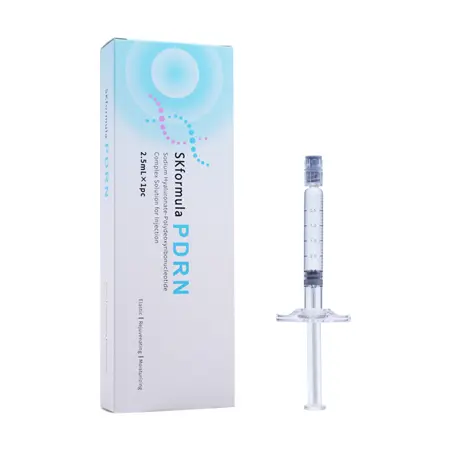Skin boosters have taken the aesthetic world by storm for their ability to hydrate, rejuvenate, and repair the skin without surgery. Two popular types leading the trend are PDRN (Polydeoxyribonucleotide) and HA (Hyaluronic Acid) skin boosters.
Though both are injectable treatments designed to enhance skin quality, they differ in their composition, mechanism of action, and results. So, which one is right for you or your patients? Let’s break it down.

Skin boosters are micro-injections of bioactive compounds that improve skin hydration, elasticity, and texture. Unlike dermal fillers, they don’t add volume—they work at the cellular level to restore skin health.
The two most popular types are:
HA (Hyaluronic Acid) Skin Boosters
PDRN (Polydeoxyribonucleotide) Skin Boosters
Hyaluronic acid (HA) is a naturally occurring sugar molecule found in your skin that holds moisture like a sponge—up to 1,000 times its weight in water.
Deep skin hydration
Immediate plumping and glow
Improved elasticity and fine lines
Stimulates fibroblasts to support collagen
Safe and suitable for all skin types
Reference: Tezel, A., & Fredrickson, G. H. (2008). “The science of hyaluronic acid dermal fillers.” Journal of Cosmetic and Laser Therapy, 10(2), 98–103.https://doi.org/10.1080/14764170701783244
PDRN (Polydeoxyribonucleotide) is a DNA-derived molecule extracted from salmon sperm, known for its ability to stimulate tissue repair and cell regeneration.
It works by activating A2A adenosine receptors, which reduce inflammation and accelerate wound healing and fibroblast activity, thereby boosting collagen and elastin production.
Repairs damaged skin and promotes healing
Reduces inflammation and redness
Improves skin elasticity and texture
Brightens dull, tired skin
Great for acne-prone or post-laser skin
Reference: Kim, J. H., et al. (2010). “Polydeoxyribonucleotide has an anti-inflammatory effect in an acute gouty arthritis model.” Korean Journal of Internal Medicine, 25(2), 193–199.https://doi.org/10.3904/kjim.2010.25.2.193
| Feature | Hyaluronic Acid (HA) | PDRN (Polydeoxyribonucleotide) |
Main Function | Hydration & plumping | Healing & regeneration |
Onset of Results | Immediate (1–3 days) | Gradual (2–4 weeks) |
Duration of Results | 3–6 months | 6–9 months |
Skin Type Suitability | All skin types | Ideal for sensitive, inflamed, or damaged skin |
Texture Improvement | Yes (via hydration) | Yes (via tissue regeneration) |
Anti-Inflammatory Effect | Minimal | High (via A2A receptor activation) |
Combination Options | Often combined with vitamins, amino acids | Often combined with HA or used post-laser/peeling |
Reference: Kim, Y. S., et al. (2016). “The effect of polydeoxyribonucleotide on skin regeneration.” Dermatologic Surgery, 42(7), 892–899.
It depends on your skin condition and treatment goals:
You want instant glow and hydration
Your skin feels dry or dull
You’re looking for visible plumping of fine lines
You’re prepping for an event or special occasion
You have inflammation, redness, or post-acne damage
You’ve had laser, microneedling, or chemical peels
You want to restore and heal skin from within
You’re dealing with sensitive or aging skin
Reference: Shin, J. W., et al. (2012). “The effect of PDRN on collagen synthesis in human dermal fibroblasts.” Journal of Cosmetic Dermatology, 11(4), 287–293.
Yes! In fact, combination formulations are becoming more popular.
Many products now include both HA for hydration and PDRN for healing, offering the best of both worlds. Some practitioners also perform layered treatments, injecting PDRN first, followed by HA a few weeks later.
Reference: Park, J. H., et al. (2020). “Clinical efficacy of combined PDRN and HA therapy in aging skin.” Journal of Dermatologic Treatment, 31(4), 396–401.
Both PDRN and HA skin boosters deliver amazing benefits—but they work differently.
HA is your go-to for hydration and instant glow.
PDRN is ideal for deep skin healing, repair, and long-term rejuvenation.
Whether you're dealing with dryness, aging, inflammation, or post-treatment healing, there's a skin booster solution designed just for you.
As always, consult with a qualified medical aesthetic provider to tailor the right plan for your skin.
Tezel, A., & Fredrickson, G. H. (2008). The science of hyaluronic acid dermal fillers. J Cosmet Laser Ther, 10(2), 98–103.
Kim, J. H., et al. (2010). Anti-inflammatory effects of PDRN in gouty arthritis. Korean J Intern Med, 25(2), 193–199.
Shin, J. W., et al. (2012). Collagen synthesis via PDRN stimulation. J Cosmet Dermatol, 11(4), 287–293.
Park, J. H., et al. (2020). PDRN + HA combination therapy in aging skin. J Dermatol Treat, 31(4), 396–401.
American Academy of Dermatology. “Skin Rejuvenation Treatments.” www.aad.org
 Call us on:
Call us on:  Email Us:
Email Us:  No. 125(E), 10th Street, Hangzhou Qiantang Area, Zhejiang, China
No. 125(E), 10th Street, Hangzhou Qiantang Area, Zhejiang, China